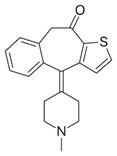Ketotifen: Useful for allergies!
Ketotifen: Useful for allergies!
By Kevin Pang
Ketotifen introduction
Ketotifen is an antihistamine that is used for a variety of medical conditions such as for asthma or allergies. It is usually available as a prescription ophthalmic medication, but it can be made into different dosage forms such as tablets, capsules, or topical creams/ointments by compounding.
Why would I use Ketotifen?
Ketotifen along with other antihistamines are very useful drugs that are used widely for medical treatment. It has a number of anti-inflammatory effects that are clinically beneficial for conditions that often involve the immune system. Ketotifen is historically an old drug, but it has a number of studied uses (such as hives and asthma) that other antihistamines may not be able to be used in.

How does Ketotifen work in your body?
Ketotifen works by inhibiting the release and/or activity of inflammatory cells (mast cell and basophil) molecules, including histamine and immune cell chemical factors. By inhibiting the release of these chemical factors, ketotifen is able to reduce the severity or even the likelihood of an allergic reaction. Inhibiting the release of histamine especially would mean that lung cells are not able to constrict and reduce the ability to breathe when exposed to an allergen.
What side effects should I know?
While ketotifen is often well tolerated, the most common experienced side effects are sleepiness, mild weight gain or skin rash. If you experience severe symptoms, please seek medical attention.
Why might one use compounding for ketotifen?
Compounding is a methodology for creating a new dosage form (such as an oral liquid, topical ointment, or a capsule without specific dyes or preservatives) that is used for medications that are not typically available commercially. Ketotifen is commercially available only as eye drops. Ketotifen may be transformed into a tablet, an oral solution, or a topical cream/ointment to better suit the uses your doctor might prescribe to you.
Why might one use compounding for ketotifen?
Compounding is a methodology for creating a new dosage form (such as an oral liquid, topical ointment, or a capsule without specific dyes or preservatives) that is used for medications that are not typically available commercially. Ketotifen is commercially available only as eye drops. Ketotifen may be transformed into a tablet, an oral solution, or a topical cream/ointment to better suit the uses your doctor might prescribe to you.
References:
- Sokol KC, Amar NK, Starkey J, Grant JA. Ketotifen in the management of chronic urticaria: resurrection of an old drug. Ann Allergy Asthma Immunol. 2013;111(6):433-436.
- Kabra SK, Pandey RM, Singh R, Seth V. Ketotifen for asthma in children aged 5 to 15 years: a randomized placebo-controlled trial. Ann Allergy Asthma Immunol. 2000;85(1):46-52.
- Ketotifen (Oral Route) Side Effects - Mayo Clinic. www.mayoclinic.org/drugs-supplements/ketotifen-oral-route/side-effects/drg-20064435.

Comments